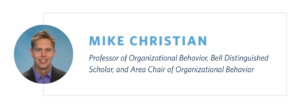Thought Leadership
Leading with Energy: 3 Steps for Staying Refreshed, Recharged, and Engaged

Leadership presents a paradox. Even when faced with an avalanche of stressors, a leader must project calmness and control. Managing the emotions of both ourselves and our teams in this way is stressful in itself, as it depletes the finite energy reserves that we rely on to keep us in peak mental, emotional, and even physical health. This means that keeping our energy “pool” as full as possible is as crucial for the health of the leader as it is for the health of the team.
UNC Professor Mike Christian’s three-step framework can help you craft and optimize your energy so that you and your team will stay refreshed, recharged, and engaged.
Stress: The Great Equalizer
The research is clear: stress impairs our ability to lead. We are less innovative and creative when we are under stress. This can manifest as a tendency to fixate on a single approach to a problem, relying on old habits, and refusing to listen to advice. These are predictable responses based on our human physiology, meaning that every leader under stress is vulnerable to these cognitive slumps regardless of their skills or experience.
Yet, there is good news. While our brains are vulnerable to stress, they also allow us to take control, interpret and strategize ways to reduce our stress, avoid burnout, and otherwise lead with energy.

Crafting Energy with AIR
You can optimize your energy and increase your resilience to stress through the “AIR” framework: Awareness, Intentional Routines, and Resilient Responses.
This framework begins with embracing the most critical lesson of stress management: you are your top priority. This truth is illustrated through the analogy of the airplane oxygen mask. Airlines advise us to first put on our own oxygen masks before helping others. Similarly, leading with energy requires caring for your own energy first. Prioritizing your own energy and doing things in a way that helps you feel more optimal is good for everybody.
Once you have given yourself permission to prioritize yourself, you can move on to optimizing and crafting your energy using the AIR framework.
Step 1: Awareness
The awareness step of the AIR framework begins with learning your own energy rhythms. Are you a “night owl,” an “early bird,” or something in between? Analyze your circadian activation patterns by paying close attention to how your energy ebbs and flows during a typical day.
Once you have learned your unique energy patterns, rearrange your daily activities to best match your energy peaks and valleys. Aligning your most energy-intensive tasks with your energy peaks can prevent energy loss.
Step 2: Intentional Routines
Leveraging intentional routines involves transforming your awareness of your daily energy rhythms into habits that will refill your energy pool. Think of your daily energy flow as a sine wave. The best time to tackle a difficult, energy-intensive task is when the wave peaks. In contrast, the best time to rest and recharge is when the wave crashes into a valley. To protect yourself from burnout, use these valleys as an opportunity to take a break and recharge rather than forcing yourself to power through.
Relaxation and meditation are also the best way to recharge. Further, be intentional about your recharge breaks by adopting the 10-90 rule. Take a 10-minute break every 90 minutes.
Step 3: Resilient Responses
As you practice being intentional about resting and recharging, pay close attention to the results. Notice the impact that you have on other people and how much more efficient you are in your work. Focusing on the rewards of crafting and optimizing your energy will train your brain. This training will transform your new energy-optimizing routine into enduring habits.
Prioritize Yourself
Leading is stressful. A team looks to the leader not only for expert advice, but also as a role model for how to negotiate stress while on the job. Therefore, to fully engage and motivate a team, a leader must prioritize caring for their own energy first. Start by learning your personal energy patterns and crafting your daily schedule accordingly. Next, optimize your energy by relaxing or meditating before burnout saps your energy reserves. Finally, strengthen your energy-crafting routine into a permanent habit by focusing on the rewards.
By giving yourself permission to prioritize your own mental and emotional health and then optimizing your energy to suit your unique energy patterns, the rewards of higher engagement and productivity will flow not only to you, but to your entire team.
If you would like to continue learning about recharging, energizing, and optimizing your habits, watch the on-demand video with UNC Professor Mike Christian, Leading with Energy. This recorded virtual event will expand on the themes outlined in this article.
